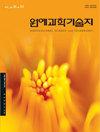桂花莎草叶中生物活性成分及抗氧化活性的季节变化
IF 0.8
4区 农林科学
Q3 HORTICULTURE
Korean Journal of Horticultural Science & Technology
Pub Date : 2023-08-31
DOI:10.7235/hort.20230037
引用次数: 0
摘要
Sasa quelpaertensis Nakai (SQ;济州鸟属(Jeju- joritdae)是韩国特有种,分布于济州岛。这种植物通常被用作一种草药茶,具有抗炎、抗癌、抗氧化和抗黑素生成的作用。利用2,2′-氮基-双-(3-乙基苯并噻唑-6-磺酸)二铵盐(ABTS+)和2,2-二苯基-1-吡啶酰肼(DPPH)测定法测定了其清除自由基的能力,同时测定了其抑制细胞活性氧(ROS)的能力。夏草叶水提物(SQW)的生物活性化合物含量和抗氧化活性随季节而变化。春季采收的黄芪总酚和类黄酮含量最高,其中香草酸和异荭草苷(6- c -糖基黄酮)含量也最高。该提取物在PC12神经元细胞中具有第二高的自由基清除活性和最高的细胞ROS抑制能力。因此,春季是采集野生南方英叶和在田间收获工业用南方英叶的最适宜季节。春天收获的SQ叶含有高水平的神经保护生物活性化合物,包括香草酸和异荭草苷,可能是预防神经退行性疾病的有希望的材料。本文章由计算机程序翻译,如有差异,请以英文原文为准。
Seasonal Variations in Bioactive Compounds and Antioxidant Activity in the Leaves of Sasa quelpaertensis
Sasa quelpaertensis Nakai (SQ; Jeju-Joritdae) is an endemic species in Korea distributed on Jeju Island. This plant, which is typically used as a type of herbal tea, has anti-inflammatory, anti-cancer, antioxidant, and anti-melanogenic effects. We investigated variations in the chemical compositions of the phenolic compounds and antioxidant activity of SQ leaves based on the harvest time and assessed its radical scavenging abilities using 2,2’-azino-bis-(3-ethylbenzothiazolin-6-sulfonic acid) diammonium salt (ABTS+) and 2,2-diphenyl-1-picrylhydrazyl (DPPH) assays, while also assessing its ability to inhibit cellular reactive oxygen species (ROS). The levels of bioactive compounds and the antioxidant activity of Sasa quelpaertensis Nakai leaf water extract (SQW) differed by season. SQW collected in the spring, in which the total phenolic and flavonoid contents were highest, also contained the highest levels of vanillic acid and isoorientin (6-C-glycosylflavone) among the different extracts collected. This extract exhibited the second highest radical scavenging activity and the highest cellular ROS inhibitory ability in PC12 neuronal cells. Thus, spring is the most appropriate season for the collection of SQ leaves from the wild and for the harvesting of SQ leaves in the field for industrial use. SQ leaves harvested in the spring, with high levels of neuroprotective bioactive compounds, including vanillic acid and isoorientin, may be a promising material for the prevention of neurodegenerative diseases.
求助全文
通过发布文献求助,成功后即可免费获取论文全文。
去求助
来源期刊
CiteScore
2.00
自引率
0.00%
发文量
0
审稿时长
1 months
期刊介绍:
Horticultural Science and Technology (abbr. Hortic. Sci. Technol., herein ‘HST’; ISSN, 1226-8763), one of the two official journals of the Korean Society for Horticultural Science (KSHS), was launched in 1998 to provides scientific and professional publication on technology and sciences of horticultural area. As an international journal, HST is published in English and Korean, bimonthly on the last day of even number months, and indexed in ‘SCIE’, ‘SCOPUS’ and ‘CABI’. The HST is devoted for the publication of technical and academic papers and review articles on such arears as cultivation physiology, protected horticulture, postharvest technology, genetics and breeding, tissue culture and biotechnology, and other related to vegetables, fruit, ornamental, and herbal plants.

 求助内容:
求助内容: 应助结果提醒方式:
应助结果提醒方式:


